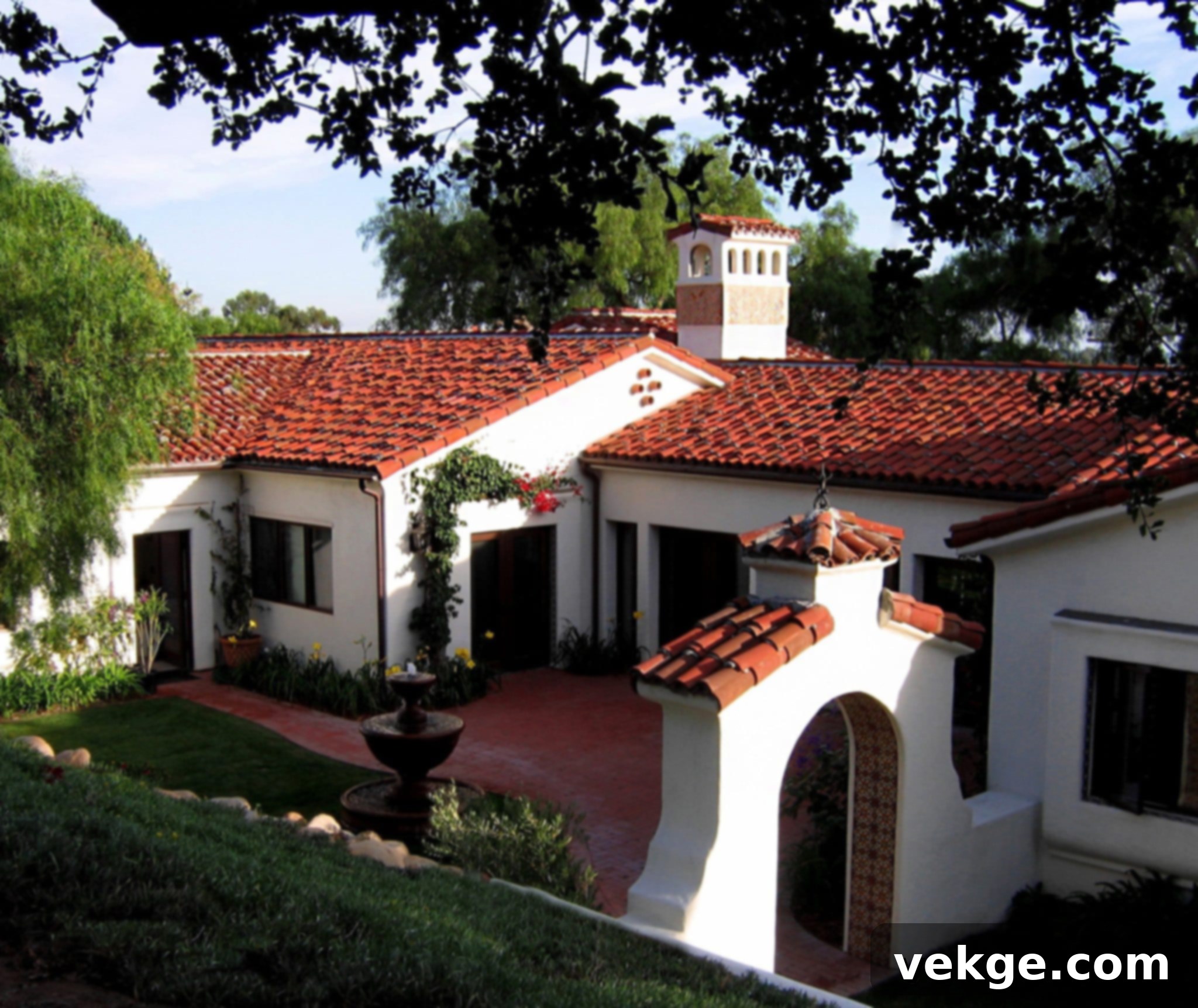Preserving the Charm: The Ultimate Guide to Maintaining Your Spanish-Style Home
Spanish architecture, renowned for its timeless beauty and practical design, has long captivated homeowners, especially in regions with warm, dry climates. Its enduring appeal saw a significant surge in popularity across the United States from 1915 to 1945, and even today, these distinctive homes continue to grace the landscapes of southeastern and coastal areas. A typical Spanish-inspired dwelling is instantly recognizable by its signature elements: pristine stucco exterior walls, warm terracotta roof tiles, and gracefully arched openings. These homes often boast meticulously designed landscapes and inviting outdoor entertaining areas, centered around secluded courtyards that serve as private oases.
However, like any architectural masterpiece, a Spanish-style home requires dedicated care and maintenance to preserve its unique aesthetic and structural integrity. The combination of its traditional materials and specific design features means that a targeted approach to upkeep is essential. This comprehensive guide will walk you through the various aspects of maintaining your Spanish-style home, ensuring its charm and elegance endure for generations.
The Enduring Allure of Spanish Architecture
Before diving into maintenance, it’s worth appreciating what makes Spanish architecture so special. Rooted in the rich cultural history of Spain and its colonial influence, particularly in regions like Florida and California, these homes are a testament to adapting design to climate. The thick stucco walls naturally provide insulation against intense heat, while terracotta tiles offer excellent durability and a rustic aesthetic. Courtyards, often featuring fountains and lush plantings, provide cool, shaded retreats from the sun, fostering a sense of tranquility and connection to nature. Decorative elements like colorful Talavera tiles and intricate wrought iron details add layers of texture and visual interest, embodying the vibrant spirit of Mediterranean design.
Understanding these core elements is the first step in effective maintenance, as each component plays a crucial role in the overall health and appearance of your home.
1. Mastering Exterior Maintenance for Lasting Appeal

The exterior of your Spanish home is its first impression, a critical aspect of its distinctive character. It comprises various elements, including stucco walls, terracotta roof tiles, and often, beautifully integrated courtyards. Regular inspection and proactive maintenance are key to keeping these features looking pristine and functioning correctly.
Caring for Stucco Walls
Stucco, a plaster-like material applied to exterior walls, is perhaps the most iconic feature of Spanish architecture. Its typical light or white color highlights any dirt or discoloration, making regular cleaning essential. Periodically inspect your stucco for signs of dirt, mildew, or algae growth, especially in shaded or damp areas. Gentle washing with a soft brush, mild detergent, and a garden hose can often restore its fresh appearance. For tougher stains, consider professional cleaning or a diluted bleach solution, always testing in an inconspicuous area first. Avoid high-pressure washing, which can damage the stucco surface or force water into underlying structures.
Beyond cleaning, meticulously check for cracks. Even small hairline cracks can allow moisture to penetrate, leading to more significant issues over time. Promptly repair any cracks you find using appropriate stucco patching compounds. For larger cracks or efflorescence (white, powdery residue), it’s advisable to consult a professional stucco repair specialist to ensure proper technique and material matching, preventing further deterioration and maintaining the wall’s integrity.
Maintaining Terracotta Roof Tiles
The warm, earthy tones of terracotta roof tiles are another hallmark of Spanish homes. These tiles are incredibly durable but require attention to prevent damage. Regularly inspect your roof for cracked, chipped, or loose tiles. Strong winds or falling debris can cause damage, compromising your roof’s protective barrier. Replace damaged tiles promptly to prevent water leaks and structural issues. Additionally, check for moss, algae, or lichen growth, which can retain moisture and degrade the tiles over time. Gentle brushing or specialized roof cleaning solutions can remove these growths. For safety and effectiveness, consider hiring a professional roof cleaner, especially for steep roofs, to ensure proper cleaning without damaging the tiles or gutters.
2. Preserving Vibrant Hues: The Spanish Color Palette
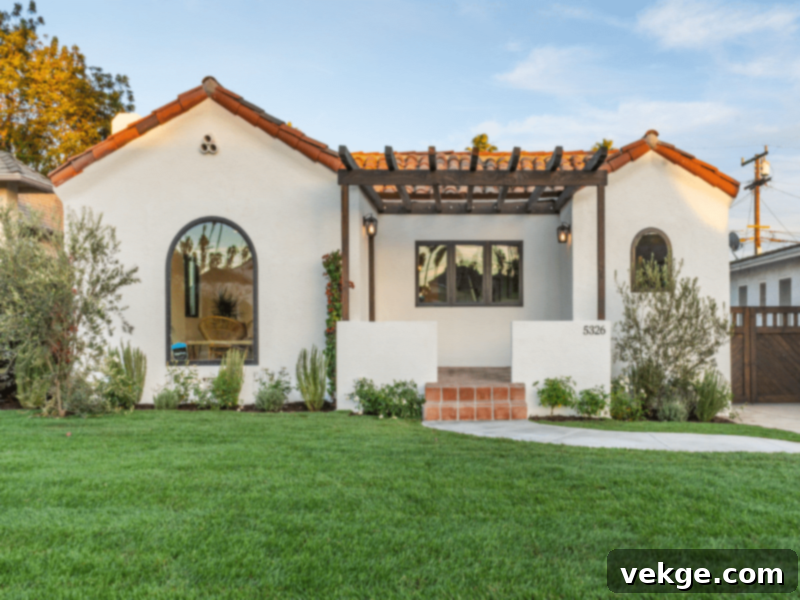
The color palette of a Spanish-style home is more than just paint; it’s an integral part of its character, evoking feelings of warmth, serenity, and a connection to the natural landscape. Typically featuring earthy tones, warm whites, and vibrant accents, these colors can unfortunately fade and wear over time due to prolonged exposure to sunlight and harsh weather conditions. Repainting is a vital process to maintain the home’s curb appeal and protect its surfaces.
When you notice the walls, trims, or architectural accents losing their original vibrancy, it’s time to consider a fresh coat of paint. Repainting not only revitalizes the aesthetic but also provides a protective layer against the elements. It’s crucial to select exterior paints that are suitable for stucco and capable of withstanding the local climate. While you can choose to match the existing colors precisely to retain authenticity, this is also an opportunity to subtly refresh your home’s look. Opt for high-quality, breathable paints that allow the walls to “exhale,” preventing moisture buildup. A fresh paint job will instantly restore the charm, vibrancy, and warm, inviting tones that are so characteristic of Spanish architecture.
3. The Art of Tile Work: Caring for Talavera and Beyond
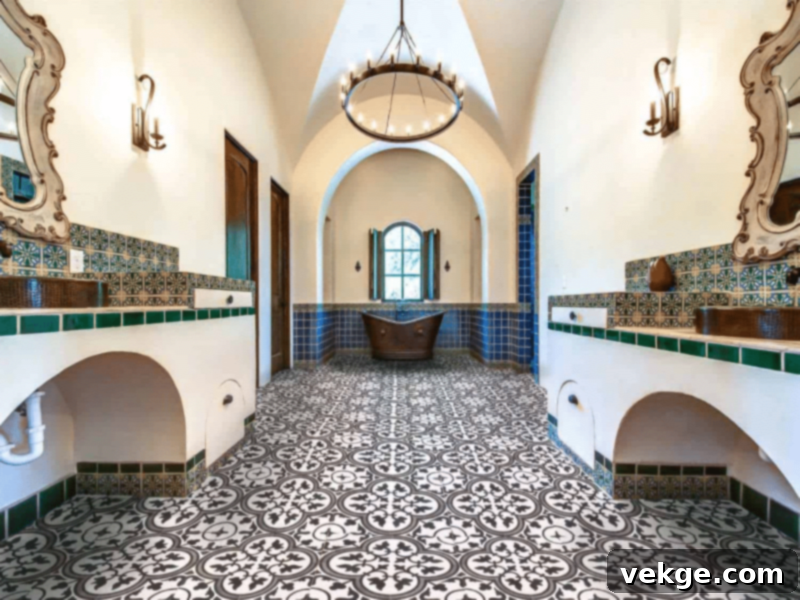
Decorative tiles, particularly the vibrant “Talavera” tiles, are quintessential to Spanish homes. Characterized by their vivid colors, intricate patterns, and often handmade designs, these tiles play a significant role in capturing the essence of Mediterranean aesthetics. Whether found on stair risers, fountain accents, kitchen backsplashes, or courtyard paving, they add an unparalleled touch of artistry and history.
Maintaining these beautiful tiles involves three key steps: cleaning, sealing, and preventing damage. Regularly inspect your tiles for any accumulation of dirt, grime, or mildew. For cleaning, use a mild, pH-neutral cleaner and a soft cloth or sponge. Avoid abrasive cleaners or harsh chemicals, which can strip away the glaze or damage the intricate patterns. Once cleaned, proper sealing is crucial, especially for porous unglazed tiles or those in high-moisture areas like bathrooms or outdoors. Sealants protect against stains, moisture penetration, and wear. Consult with a tile specialist to choose the right sealant for your specific tile type and application, and adhere to recommended reapplication schedules. Finally, prevent damage by avoiding heavy impacts, protecting outdoor tiles from extreme temperature fluctuations if possible, and ensuring that any loose tiles are re-adhered promptly. Talavera tiles are not just decorative; they are a cultural and aesthetic cornerstone, deserving of careful preservation.
4. Comprehensive Regular Cleaning and Maintenance
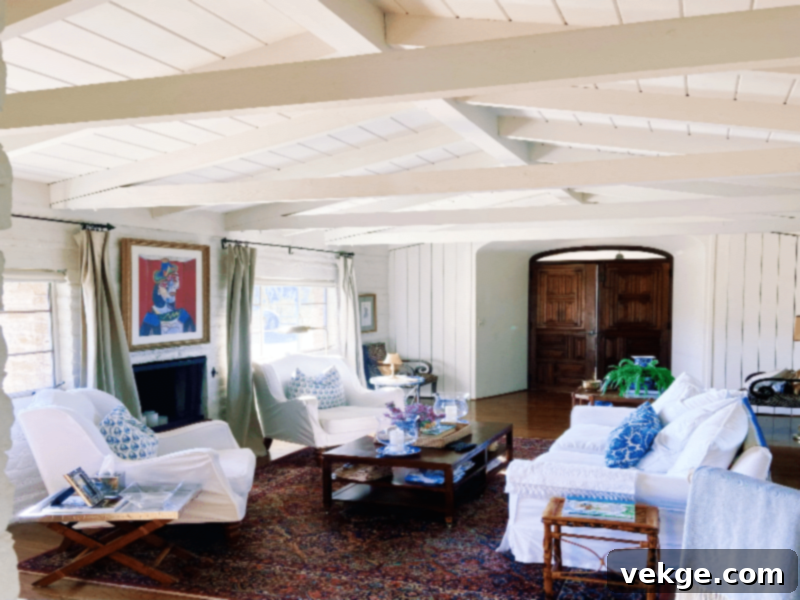
A holistic approach to cleaning and maintenance extends beyond specific architectural features to encompass the entire home, both inside and out. This continuous effort is vital not only for aesthetics but also for preventing minor issues from escalating into costly repairs.
Routine Cleaning and Pest Control
Establish a routine cleaning schedule for all surfaces, including floors (tile, wood, or other), windows, and fixtures. Dusting, vacuuming, and wiping surfaces regularly prevent the buildup of grime that can diminish your home’s visual appeal. Additionally, implement effective pest control measures. Spanish homes, with their courtyards and often older construction, can be susceptible to pests. Regular inspections, sealing cracks and gaps, and professional pest services when necessary will protect your home from unwanted intruders.
HVAC, Window, and Garden Care
Don’t overlook the operational systems of your home. Regularly clean or replace HVAC filters and schedule professional servicing for your heating and cooling systems to ensure efficiency and air quality. For windows, clean the glass and frames, and inspect seals and caulking for any signs of wear that could lead to drafts or moisture intrusion. The garden and landscape surrounding your Spanish home are an extension of its beauty. Maintain them with regular watering, pruning, and weeding. Ensure proper drainage around the foundation to protect stucco and prevent water damage.
Seasonal Maintenance and Damage Inspection
Adapt your maintenance routine to the seasons. This might involve gutter cleaning in the fall, checking for roof damage after winter storms, or preparing irrigation systems for summer. Crucially, conduct regular, thorough inspections for any signs of damage—be it water stains, structural cracks, or wear and tear on materials. Addressing these issues promptly is the most effective way to prevent them from becoming more severe and expensive to repair, ensuring the longevity and charm of your Spanish-style residence.
5. Nurturing Feature Courtyards and Outdoor Spaces
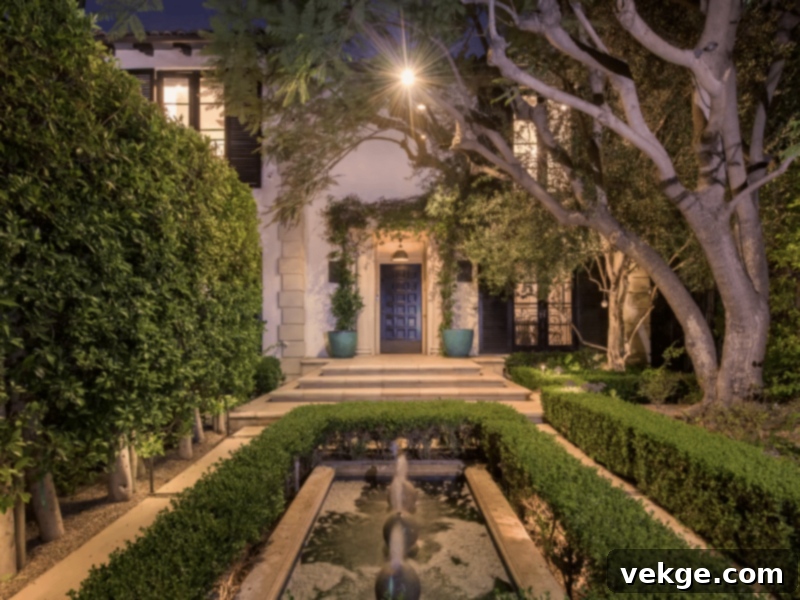
Courtyards are central to the Spanish architectural experience, offering a private outdoor sanctuary. Maintaining this crucial space ensures it remains an inviting and beautiful extension of your home.
Paving and Landscaping
Regularly sweep your courtyard or patio to remove leaves, dirt, and debris that can accumulate and stain surfaces. For tiled or paved courtyards, periodically scrub with a mild cleaning solution to remove grime and prevent moss or algae growth. Ensure that any paving tiles are properly sealed to protect them from stains and weathering, and re-seal as needed. Trim and prune plants, shrubs, and trees regularly to prevent overgrowth, which can obstruct pathways, block sunlight, and potentially damage surrounding structures or obscure architectural details. Opt for drought-tolerant plants that thrive in your climate to reduce water consumption and maintenance.
Water Features and Furniture
If your courtyard includes a fountain or other water feature, regular cleaning is essential to prevent algae buildup, clogs, and unpleasant odors. Drain, clean, and refill fountains periodically, and inspect pumps for proper functioning. For any outdoor metal furniture, protect it from rust by regular cleaning and, if necessary, repainting it with rust-resistant outdoor paint when you notice fading or chipping. For wooden furniture, apply appropriate sealants or stains to protect against weather damage. By dedicating attention to these elements, your courtyard will continue to be a cherished retreat.
6. Thoughtful Interior Furnishings
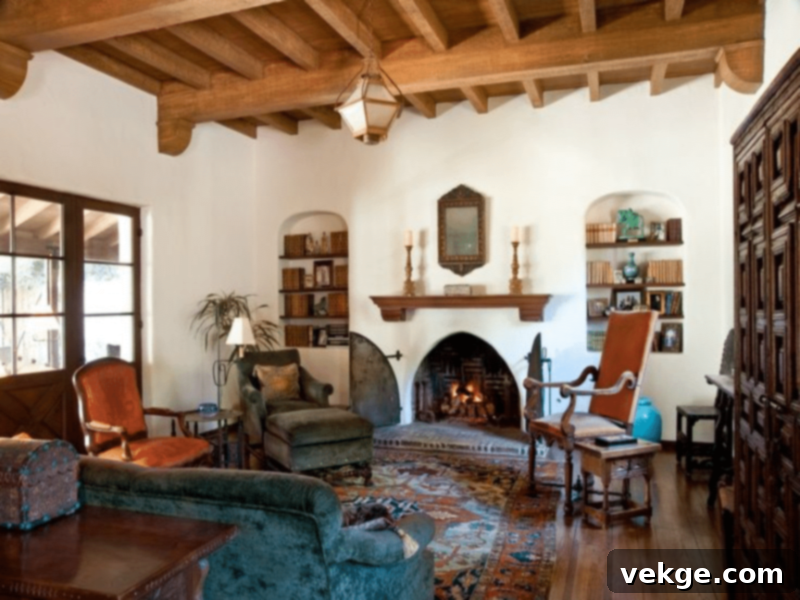
Just as the structure of your home requires care, so too do your interior furnishings. The furniture you choose for a Spanish-style home often features robust materials like dark hardwood, which, while durable, still benefits greatly from regular maintenance.
Daily dusting and weekly cleaning with appropriate wood polishes or cleaners can help preserve the luster of your wooden pieces. Address any scratches or dings as soon as they appear using wood repair kits or touch-up pens to prevent further damage and maintain their aesthetic appeal. If you share your home with pets, consider using furniture covers, especially for upholstered pieces, to protect them from scratches, fur, and dirt. For upholstery, vacuum regularly and spot clean spills immediately with suitable fabric cleaners. Protecting your furniture not only extends its lifespan but also ensures it continues to complement the rich, warm ambiance of your Spanish-inspired interior.
7. Preserving Wrought Iron Details
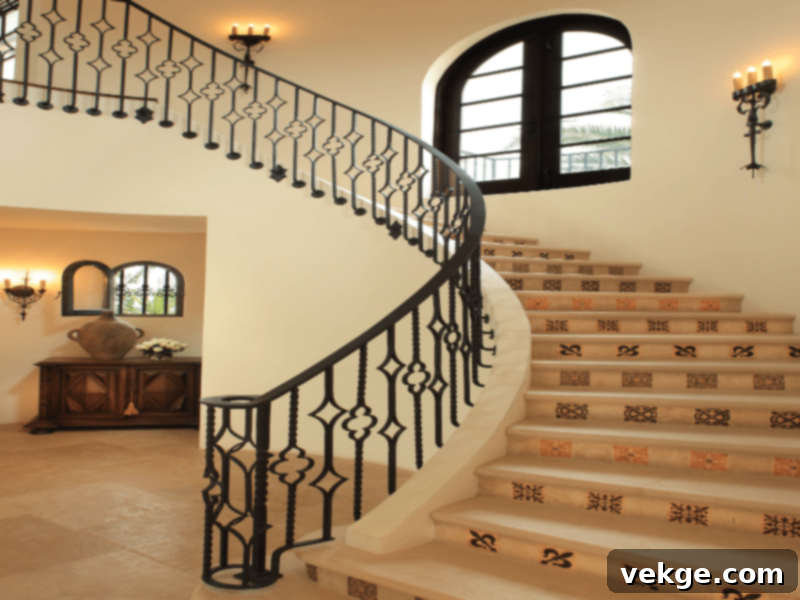
Wrought iron elements are a distinctive hallmark of Spanish architecture, adding a touch of rustic elegance and craftsmanship. These details can be found in various forms, including light fixtures, railings, gates, window grilles, and decorative accents, both indoors and outdoors. Their intricate designs and robust nature contribute significantly to the authentic feel of a Spanish home.
To maintain these beautiful wrought iron features, preventing rust is paramount. Regularly clean the ironwork with a soft cloth and mild soap and water to remove dirt, dust, and any accumulated moisture. After cleaning, ensure it is thoroughly dried to prevent rust formation. For outdoor pieces exposed to the elements, consider applying a protective wax or a clear sealant annually. If you notice any signs of rust developing, address it immediately. Gently remove surface rust with a wire brush or sandpaper, then treat the area with a rust-inhibiting primer before repainting with a high-quality, weather-resistant paint specifically designed for metal. This diligent care will ensure your wrought iron details retain their beauty and structural integrity for years to come.
8. Incorporating and Maintaining Colonial-Inspired Elements

The Spanish colonial influence often brings with it a distinctive style of interior furnishings characterized by heavy and oversized pieces made of dark hardwood. These elements not only add to the authentic feel of a Spanish-style home but are also known for their durability, designed to last for generations. Examples include substantial accent tables, elongated dining tables, high-backed chairs, and impressive, high bedding headboards.
Maintaining these beautiful pieces involves regular care to preserve the rich patinas of the dark wood. Dust regularly with a soft cloth. For cleaning, use wood-specific cleaners that condition the wood and prevent drying. Avoid placing these pieces in direct, harsh sunlight, which can cause fading or cracking over time. Address any spills immediately to prevent stains, and use coasters and placemats to protect surfaces from heat and moisture. Periodically, apply a quality furniture wax or oil to nourish the wood and enhance its natural sheen. By giving these colonial-inspired elements the care they deserve, they will continue to be stunning, functional centerpieces in your home for decades.
9. Highlighting Architectural Features: Arches, Niches, and Alcoves
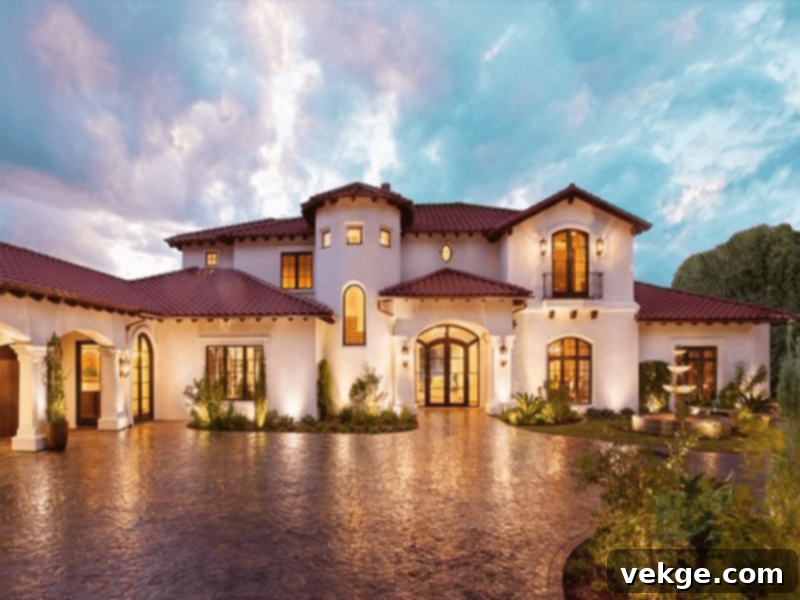
Beyond the primary materials, Spanish architecture is rich with distinctive architectural features that define its interior flow and character. These include graceful arches, practical niches, and cozy alcoves.
Arches
Arches are fluid, curved openings frequently found in doorways, windows, and interior passages. They soften the lines of a home and create a sense of grandeur and flow. Maintain arches by regularly cleaning their surfaces, whether they are stucco, plaster, or wood. Inspect for hairline cracks in the plaster or paint, which should be repaired promptly to maintain a seamless finish. Ensure that any decorative elements on or around the arches, such as carved wood or tile work, are also cleaned and cared for.
Niches
Niches are recessed areas within walls, specifically designed to display artwork, sculptures, pottery, or other decorative items. They add depth and a curated feel to the interior. Keep niches clean and free of dust, as they are often focal points. Ensure that the items displayed within them are secure and that the niche itself shows no signs of structural issues or moisture. The goal is to keep them pristine backdrops for your cherished possessions.
Alcoves
Alcoves are small, often semi-enclosed spaces found within larger rooms or walls, typically offering a sense of seclusion or a dedicated functional area. They might serve as reading nooks, built-in seating areas, or even small office spaces. Maintain alcoves by keeping them tidy and organized. Depending on their function, ensure lighting is adequate, surfaces are clean, and any textiles or cushions are regularly cleaned or aired out. These intimate spaces contribute significantly to the comfortable and inviting atmosphere of a Spanish home.
10. Harmonious Interior Maintenance
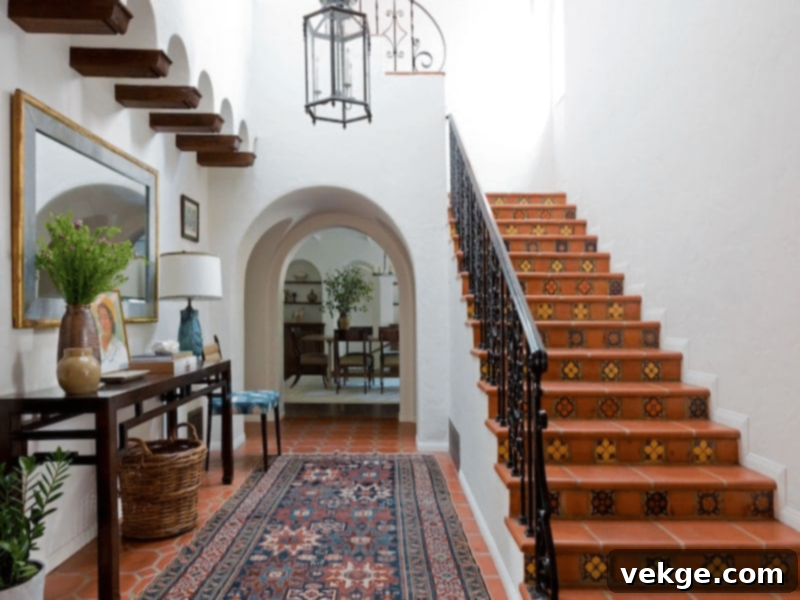
The interior of your Spanish-style home is where comfort meets character. Proper interior maintenance is not merely about keeping things clean; it’s about fostering a positive vibe and ensuring that every element harmonizes with the architectural style. The aesthetic integrity of your home relies on a consistent approach to its interior spaces.
Beyond the regular dusting and cleaning outlined earlier, thoughtful interior maintenance involves curating an environment that reflects the warmth and inviting nature of Spanish design. Ensure that the furniture you choose complements the architectural elements, opting for pieces that resonate with the heavy, rich textures and earthy tones typical of the style. Keep spaces uncluttered to allow the architectural features, such as arches and tiled floors, to shine. Regularly inspect walls and ceilings for any signs of water damage, cracks, or paint chips, addressing them promptly. Paying attention to details like proper lighting, the freshness of air, and the overall cleanliness of every room contributes to a beautiful and positive living environment that truly embraces the spirit of your Spanish-inspired home.
Conclusion
Maintaining a Spanish-style home is a commitment to preserving a rich architectural heritage. By paying diligent attention to these specific details—from the robust stucco exteriors and terracotta roofs to the vibrant Talavera tiles, intricate wrought iron, and inviting courtyards—homeowners can ensure their property retains its timeless beauty and authentic charm. Blending traditional Spanish architecture with modern maintenance practices creates a unique atmosphere that is not only visually stunning but also enduringly comfortable and functional.
The continuous care you invest in your Spanish-style home safeguards its structural integrity and ensures that its inviting, timeless touch continues to welcome residents and guests for generations. It’s a rewarding endeavor that connects you to a rich history and a distinctive aesthetic.
Do you have a home inspired by Spanish architecture? We’d love to hear if these tips were helpful to you! Share your experiences and insights in the comment section below.
Frequently Asked Questions
What Influenced Spanish Architecture Homes?
Spanish architecture in the United States was largely influenced by Spain’s colonial past, particularly in regions like Florida and California, which were under Spanish rule. This architectural style draws heavily from Mediterranean traditions, including Moorish influences (evident in intricate tilework and arches) and indigenous building practices. It became widely popular during the Colonial Revival and Spanish Colonial Revival periods, primarily between 1915 and 1945. These homes are still a common and cherished sight in many parts of the U.S. today, reflecting a blend of history, climate adaptation, and aesthetic appeal.
What Makes a Home Spanish Architecture?
A home is distinctively recognized as Spanish architecture through a combination of several key characteristics. These typically include smooth, often light-colored stucco exterior walls and iconic red terracotta barrel tiles on the roof. Further identifiers are graceful arched doorways, windows, and passages; intricate wrought iron details on gates, railings, and fixtures; and often, enclosed courtyards that provide private outdoor living spaces. Minimal embellishments, thick walls, and the use of natural materials like stone and wood contribute to their uniform yet aesthetically pleasing appearance, creating homes that are both beautiful and well-suited to warm climates.
How Often Should Stucco Be Cleaned and Repaired?
Stucco should ideally be inspected annually for cracks and signs of mildew or algae. Routine cleaning with a soft brush and water can be done as needed, typically every 1-3 years, or when visible dirt accumulates. Larger cleaning efforts, or professional cleaning, might be necessary every 5-10 years. Any cracks or damage should be repaired promptly to prevent water intrusion and larger structural issues.
Are Spanish-Style Homes Energy Efficient?
Traditional Spanish-style homes, with their thick stucco walls and terracotta roofs, were originally designed for climate control. The mass of the stucco helps to insulate against heat, keeping interiors cool in warm climates. While older homes may lack modern insulation standards, their inherent design elements offer natural energy benefits. With modern upgrades such as improved insulation, double-pane windows, and efficient HVAC systems, Spanish-style homes can be highly energy efficient, blending historic charm with contemporary comfort.
